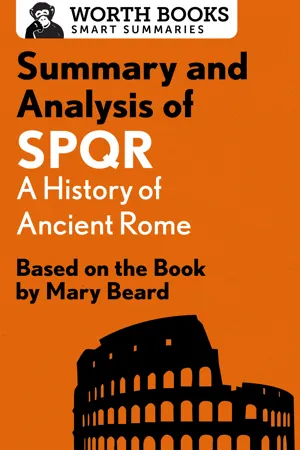Summary
Prologue: The History of Rome
In the prologue, Beard argues for the continued relevance of ancient Rome in contemporary Western society as the source of concepts such as liberty and citizenship, as well as imperialist conquest. She notes that historical scholarship is always in flux as new archaeological discoveries are made or reinterpreted. She explains why she chose to end SPQR in 212 CE with emperor Caracalla’s declaration of citizenship for all empire inhabitants, as this was the moment that struck down the boundaries between Rome itself and its foreign colonies. She also states her aim to reexamine the way Rome is commonly thought of in the public imagination, for it was more than a violent and aggressively unselfconscious superpower.
Chapter One: Cicero’s Finest Hour
Beard begins the narrative but with a fundamental incident that provides vital context for understanding Roman politics. It is the 63 BCE coup organized by Lucius Sergius Catiline to overthrow the government and abolish debt. Consul Marcus Tullius Cicero—hearing of the plot from an informer—came before the senate to argue for action in a series of speeches called Against Catiline that are still widely read today.
Though it is difficult to definitively pinpoint Catiline’s exact motivations—most of the available source material on the coup was written by Cicero—it is known that Catiline was embittered by a loss to Cicero in the 64 and 63 BCE consul elections. Cicero’s documents are generally the most abundant and reliable resource for Roman scholarship, though they tend to be colored by their author’s vanity and inflated sense of self.
After Cicero spoke to the senate, Catiline’s accomplices were arrested and executed without trial. Catiline was killed in a clash with Roman military. Five years later, Cicero’s execution of the Catiline conspirators was deemed excessive and he was exiled to Greece. This incident mirrors treatment of individuals suspected of terrorism in the modern world who are regularly stripped of their basic civil rights and punished without sufficient evidence.
Beard points out that this traditional view of the incident fails to take into account the fact that, at the time of the attempted coup, income inequality was rampant, and those in debt could hardly afford to eat. Catiline and his followers had legitimate grievances. Cicero may have also exaggerated the severity of their plot to make himself appear heroic.
Need to Know: The Catiline conspiracy is a distinctively Roman story of the eloquent statesman versus the ambitious would-be usurper, featuring shady machinations, grand speeches, open rebellion, and, of course, executions.
Chapter Two: In the Beginning
The most well-known story of Rome’s founding comes to us from the historian Titus Livius, or Livy. Twin brothers Romulus and Remus were born to a virgin priestess whose father ordered the boys to be drowned immediately after their birth. They survived, were adopted and suckled by a wolf, and went on to found Rome, after which Romulus promptly murdered his brother over a land dispute.
Romulus invited the dregs of Italian society to join his citizenry, the “runaway slaves, convicted criminals, exiles and refugees.” This band of degenerates abducted a group of women from the neighboring Sabines and made them their wives. While Livy defended these actions (pointing out, for example, that the early Romans took only the unmarried women), historian Gaius Sallustius Crispus, also known as Sallust, criticized the incident for its brutality.
As for the fratricide, several historians, Cicero included, expunged it from their records of the foundation altogether. There is a second foundation myth featuring Aeneas from Homer’s Iliad, and Roman historians tried to reconcile the two versions by making Romulus a distant relation of Aeneas.
The date of Rome’s founding is also somewhat speculated. Archaeological evidence points to around 750–700 BCE, and the Romans themselves placed it at 753 BCE. In reality, the foundation was probably a gradual merging of several small towns in the area into one grand settlement, evidenced by the distinct names given to Rome’s seven hills.
Need to Know: The stories of Romulus and Remus and the Rape of the Sabines (as this incident has come to be called) are central myths that represent major themes in Roman politics: assassination, Civil War, and imperialistic seizure. This suggests that the legends may have been invented later in Rome’s history, with the benefit of hindsight.
Chapter Three: The Kings of Rome
Following Romulus, Rome was ruled by a series of kings, though Beard notes that they were, like their subjects, more primitive than the title suggests, stating that “chiefs” is perhaps more accurate. In addition to the written histories, evidence of a Roman monarchy was found on a pillar discovered in the Forum in 1899, with the inscription “RECEI” or, “to or for the king.”
Accounts from nearby civilizations, such as the Etruscans, also entered the historical record at this time, and from them, we further learn that this era was not only marked by violence and upheaval, but also by innovation. One king, Servius Tullius, created a rudimentary version of the census; another, Numa Pompilius, instituted religious offices with terms like “pontiff” that are still in use today. He also formulated the twelve-month calendar.
Roman society was spiritual at this time, though it was a practice based on placa...
